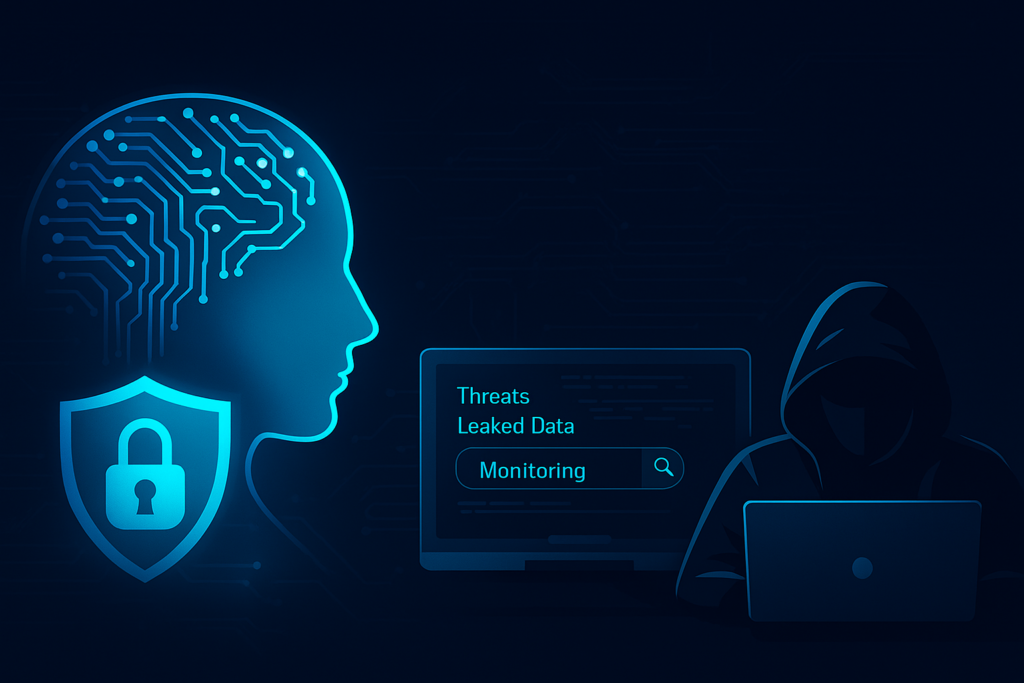Introduction
In today’s hyper-connected digital world, cybersecurity threats are becoming more sophisticated and persistent. One of the most concerning areas is the dark web, where stolen data, malicious tools, and illegal services are traded. Artificial Intelligence (AI) is playing a crucial role in revolutionizing how organizations detect, prevent, and respond to these threats in real-time.

How can we leverage AI for cybersecurity and dark web monitoring?
Artificial Intelligence (AI) can significantly enhance cybersecurity by detecting threats in real-time, identifying anomalies, automating incident responses, and continuously learning from data to improve defenses. In the context of dark web monitoring, AI helps by scanning and analyzing hidden forums, marketplaces, and chat groups to identify stolen data, leaked credentials, or emerging threats—allowing organizations to act proactively and mitigate risks.
Why AI is a Game-Changer in Cybersecurity
- Speed & Scalability: AI can analyze vast amounts of data from networks, logs, and users in seconds—far beyond human capability.
- Real-Time Threat Detection: Machine learning models learn patterns and behaviors to instantly detect anomalies or suspicious activities.
- Predictive Analysis: AI can foresee threats based on behavior and context, helping prevent breaches before they happen.
- Automated Response: AI-driven systems can isolate threats, trigger alerts, or block access without human intervention.
Role of AI in Dark Web Monitoring
The dark web is a breeding ground for cybercriminal activities. AI enhances monitoring efforts in the following ways:
- Data Scraping & Indexing: AI bots can crawl and extract data from hidden forums and marketplaces.
- Keyword & Pattern Recognition: NLP-powered tools identify sensitive data like company names, credentials, or personal info.
- Threat Correlation: AI links dark web mentions with ongoing cyber activities to assess potential risks.
- Alerting and Reporting: Instant alerts are generated if a company’s data is found on suspicious platforms.
Use Cases
- Phishing Attack Prevention
AI detects fraudulent emails and URLs by analyzing behavior and content patterns. - Credential Leak Detection
Dark web scanners powered by AI can alert security teams when employee or customer credentials are compromised. - Insider Threats Monitoring
AI monitors access logs and usage behavior to detect anomalies within the organization.
Tools That Leverage AI for Cybersecurity
- Darktrace – AI-driven network monitoring and anomaly detection.
- CrowdStrike – Threat intelligence and endpoint protection using machine learning.
- Recorded Future – Real-time dark web monitoring and risk scoring.
- SpyCloud – Uses AI to track stolen credentials and accounts.
Challenges and Considerations
- Evasion Tactics: Cybercriminals continuously evolve their tactics to evade detection, posing a challenge for AI systems.
- False Positives: AI systems may sometimes generate false positives, which can lead to unnecessary alerts and resource allocation.
- Data Privacy: Ensuring data privacy while monitoring the dark web is crucial to avoid legal and ethical issues.
- Ethical Use of AI – Surveillance and privacy concerns must be managed carefully.
- Skill Gap – Organizations need skilled personnel to manage and interpret AI tools.
Conclusion
AI is not just a buzzword in cybersecurity—it’s a powerful ally. By leveraging AI for cybersecurity and dark web monitoring, organizations can proactively protect their data, detect threats faster, and stay one step ahead of cybercriminals. As technology continues to evolve, integrating AI-driven security solutions will become essential for every forward-thinking business.